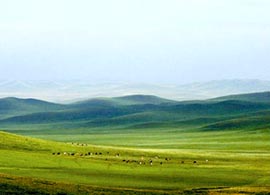
Inner Mongolia, the third largest provincial region in China, usually attracts a crowd of visitors from across China, South Korea and Japan from July to September, the time the traditional Mongolian Nadam Festival is being held. It is also to best time to participate in the lively atmosphere of grassland life.
A vast majority of the autonomous region, mostly over 1,000 meters above sea level, is relatively flat, the ideal environment the Mongolians needed to cultivate their horsemanship and skillful cavalry tactics.
Inner Mongolia has a long, bountiful history and brilliant culture. There are many historic sites in this area. It was the home of Genghis Khan (1162-1227), the greatest leader of the Mongolians. His Mausoleum, 185 kilometers south of Baotou, holds a collection of his uniforms and armor as mementos to his memory.
However, what is most attractive about Inner Mongolia is its unique natural scenery. The vast area of grasslands, including the Xilamuren, Gegentala, and Huitengxile Grasslands, are excellent places to immerse oneself in the experience of rolling grass and clear skies watching flocks of birds move like white clouds, with mushroom-like yurts offering shelter.
Tempt yourself to try the many different activities available, such as horse and camel riding, rodeo competitions, archery, even Mongolian wrestling, before relaxing with traditional Mongolian families and enjoying their graceful singing and dancing.
There are also many deserts in Inner Mongolia, located in the western part of the region. The most famous and most visited are the Badain Jaran, Tengger, and Kubuqi Deserts. Now until the end of September is the best time to explore the desert while temperatures are moderate.
As capital of the autonomous region, Hohhot offers easy accessible transport to begin your exploration of Inner Mongolia. Planes, trains, and buses are all available to get you to the Mongolian capital from Beijing. Our suggested itinerary commences from this point.
Day 1: Take the time to visit Hailar, but if this is not an option, head straight for the grasslands surrounding Hohhot. This can be done independently or through a Hohhot travel agency. Whichever you choose, spend at least one night in a yurt.
Day 2: Continue enjoying yourself around the grasslands, then head back to Hohhot for the evening. Check in to a local hotel.
Day 3: In the morning, take a bus to Dazhao Temple. Enjoy a light feast at one of the restaurants close by. In the afternoon, visit the Xilituzhao Temple before heading for the Five Pagoda Temple, both within walking distance from Dazhao.
Day 4: Rent a bike and give yourself the morning to visit the Inner Mongolia Museum and Great Mosque. In the afternoon, cycle to the Tomb of Wang Zhaojun, lady-in-waiting at the Western Han (206 BC-25 AD) court who volunteered to marry the chief of Xiongnu. Take an evening train to Baotou (from Donghe Railway Station on the east side of town) and relax at one of the local hotels.
Day 5: Spend the morning at Wudangzhao Monastery. Return to the railway station for lunch before taking a coach to Dongsheng, where you will stay for the night.
Day 6: Make your way to Genghis Khan's Mausoleum. On returning to Dongsheng, embark on the tourist train to Resonant Sand Gorge. In the evening, take the train back to Donghe Railway Station in Baotou.
Most of the attractive destinations in the autonomous region can be seen within a week.
Note: The temperature fluctuation between day and night is immense, so please take an extra layer of clothing with you during your discoveries.
Although, Inner Mongolia belongs to a moderate monsoon climate, it is still relatively dry, especially in the western regions. Seasonal differences in temperature are as extreme as the daily ones, so watching weather forecasts before arrival is particularly worthwhile. It is also advisable to take warm clothes with you even in summer.
The Nadam festival is an ancient festival, a part of the Mongol tradition linked to the Aobao festival. Ancient stone piles found all around Inner Mongolia, especially around the grasslands, are called aobao in the local language.
The festival is a carnival celebrating all things Mongolian, with many traditional sports being played.
The festival is linked to the traditional Chinese calendar, so it is held on a different date every year. Usually, the date falls around the middle to end of August.
The best place to experience Nadam is in Hohhot, where most locals and foreigners will revel in the festivities. Most of the activities are held in the Horse Racing Grounds, in the northern part of town.
(China Weekend August 30, 2004)
|

